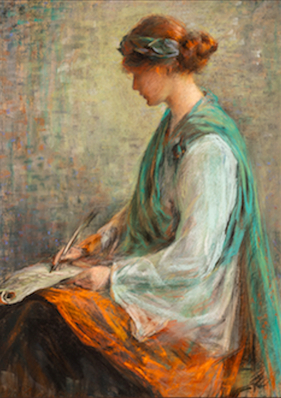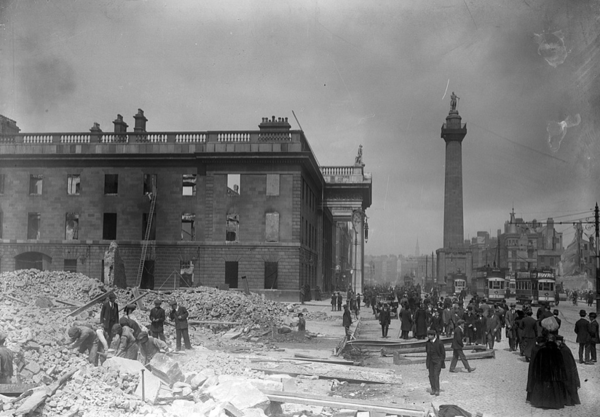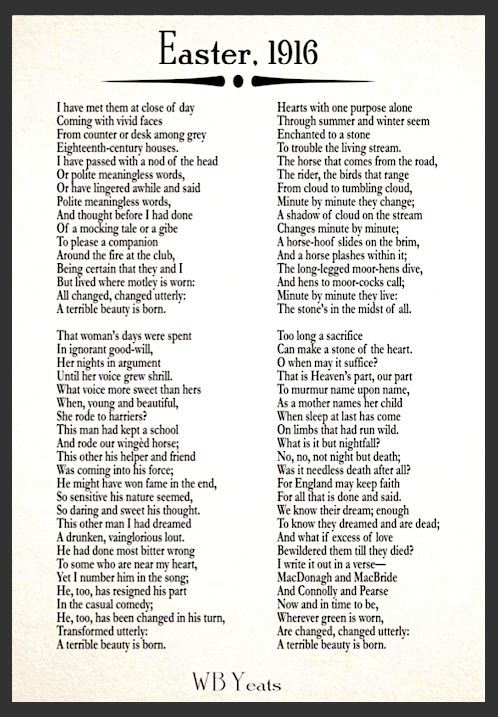Hibernia

Elizabeth "Lily" Williams
Elizabeth "Lily" Williams, ARHA (Irish, 1874–1940)
"Hibernia" (1916)
Pastel, 65.5 x 42 cm. (25.8 x 16.5 in.), The O'Brien Collection
Elizabeth "Lily" Williams grew up in a progressive Presbyterian household, which nurtured her artistic talents from an early stage. Having trained under May Manning (at the famed Dublin Metropolitan School for Art) and then, at The Royal Hibernian Schools, under Walter Osborne, her loose impressionist style was allowed to develop alongside that of her immediate contemporaries, Beatrice and Dorothy Elvery, Grace Gifford, and Estella Solomons, the latter two of whom would have heightened her awareness of the Gaelic revival and its accompanying Nationalism.
Williams' family home at 104, Marlborough Road hosted ''literary afternoons'' which were attended by the likes of lifelong friend Arthur Griffith. In Protestant Nationalist circles, Griffith was popular for his provocative non-violent policies.
Williams is best known for her subtle pastel portraits of leading Nationalists of the day, including Griffith, Padraig Colum, and The O'Rahilly. At Griffith's request she also designed "stamps" for Sinn Fein in 1907. They were to be placed alongside official stamps and had the dual purpose of raising both funds and the profile of Sinn Fein. One of the two "stamp" images designed by Williams was of the romantic Cathleen Ni Houlihan, a personification of Ireland also used by Sir John Lavery and ultimately found on the old Series B pound notes.
It is this Nationalist ethos which permeates "Hibernia." The beautiful figure, seated and alert, writes with a quill on to parchment draped in the tri-color. She personifies the national awakening and is as anonymous as she is all embracing, an icon for her times. (Comparisons can be made between ''Hibernia'' and a work by fellow art student Beatrice Elvery (aka, Lady Glenavy) entitled "Eire" executed by Glenavy in 1907.
Biography of Lily Williams courtesy of Adams.ie
_________
Mr. Fahey comments:
"It is one of the challenges of art history that, though imagery survives, context often dwindles. Such is the case here. Today, our widespread familiarity and acceptance of the Irish Tri-Color flag may give one the impression that this image is merely interesting, romantic, perhaps sweet; nothing of its controversial flavor is available to our consciousness today. But when this was drawn, it was highly controversial in general and within Williams' own family. The Tri-Color was illegal to be flown or shown in 1916, and to drape the age-old national symbol of Hibernia in it—especially at that moment-—well, that was quite courageous. Also, unlike previous iterations of Hibernia (typically seen astride the common symbols of the Irish wolfhound, the harp, etc.) here, Hibernia is overtly draped in the business of the Rising and in its hoped-for result, independent statehood, as she pens the Constitution. And, lest there be any remaining uncertainty as to the artist’s feelings, Hibernia is wearing the classical crown of victory about her head: laurel leaves. Though it was first gifted to a delegation of patriotic Irishmen who went to France in 1848 to learn how the French rid themselves of aristocratic rule, the Tri-color remained largely “under wraps” until 1916 as it was illegal to display it."
[For further information on Lily Williams, please refer to the feature on her ''Comrades and Friends'' by Hilary Payle, Irish Art Review, Summer 2013 (see this LINK)]
Below, a very early Tri-Color belonging to Willie Halpin.

To further illustrate the events of 1916, the year Lily Williams created "Hibernia," Mr. Fahey offers a second image: The clock from the General Post Office (GPO), the site of major events in the 1916 Rising.

The GPO Clock: 1916
This is an astonishing survivor/relic of a momentous event and time. If this clock could talk, what would
it tell us about the events it witnessed first-hand?

The GPO in the aftermath of the Easter Rising
_______________________________________________________________________________________
Poetic reflection: Easter, 1916 by William Butler Yeats
Many have commented on the emotional and intellectual trajectory that is evident in this
piece. While WB Yeats was clearly opposed to the violence associated with the Rising, there is, too, an acknowledgement that this event (especially after the executions of the Leaders of the Rising) would forever change Ireland's political and historical landscape.

_________________________________________________________________________________________________________________________________________________________________________________________________________
Music and further reading to AMPLIFY the experience of "Hibernia" and the GPO clock:
-Sean O’Riada’s soundtrack for the film, ‘Mise Eire’ (Mobilisation, 1916)
LISTEN [Please scroll down to Track 15]
Joanie Madden Women Of Ireland Mna Na H Eireann
-Ductia La Ultime Estampie Real Saltarello
Ensemble Galilei (band), Alta (album) c/o Liz Knowles and Ensemble Galilee
From Liz Knowles regarding this track: This track of music has always struck me as "music about Time". These are three Medieval dance melodies that have a timeless quality about them and yet feel very much of their age. They also have time embedded in them: The first tune has two melodies running simultaneously, both with similar phrase lengths and yet they feel like very different voices, almost as if they are talking over each other, simultaneously, and though these conversations sit harmoniously on top of one another, they seem to be saying very different things. Hibernia sits sweetly, bathed in gentle light but wears the colors of another conversation, another time, one of a very different character. These two elements of light and color by themselves look like silence, solitude and introspection but we know them to possess meaning that is quite the opposite. The middle tune in the set holds time in place with that melody that is both melancholic and sweet. There is a room created with this arrangement of the melody, the harp holding a metronomic, clock-like repetition creating a gently walled room inside which the melody floats. Hibernia, sitting with pen in hand, sits in a room that we cannot see, she is focused on what she is writing or about to write, draped in that ethereal fabric. Time and imagery hold the paradox. The last tune is full of pushing and pulling at time, an improvisatory restraint on the melody at first with explosive movement to follow.
Liz Knowles
“The Foggy Dew”
Finally, in the world of contemporary Irish art, perhaps no one has spent more time focusing on the events surrounding 1916 (and the subsequent conflicts up to and including 1921-22) in the visual arts than the esteemed artist, Mick O’Dea. Here is a video of an exhibit that he launched in 2016 at the RHA, Dublin, wherein he both depicted and discussed these topics.
WATCH Mick O'Dea "The Foggy Dew"